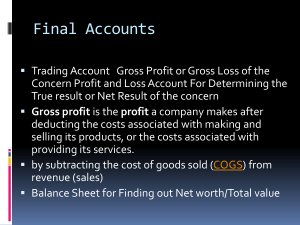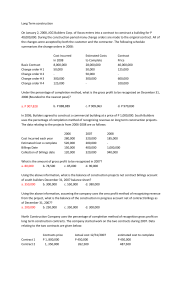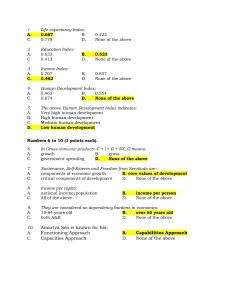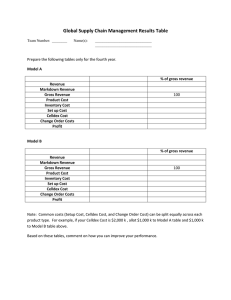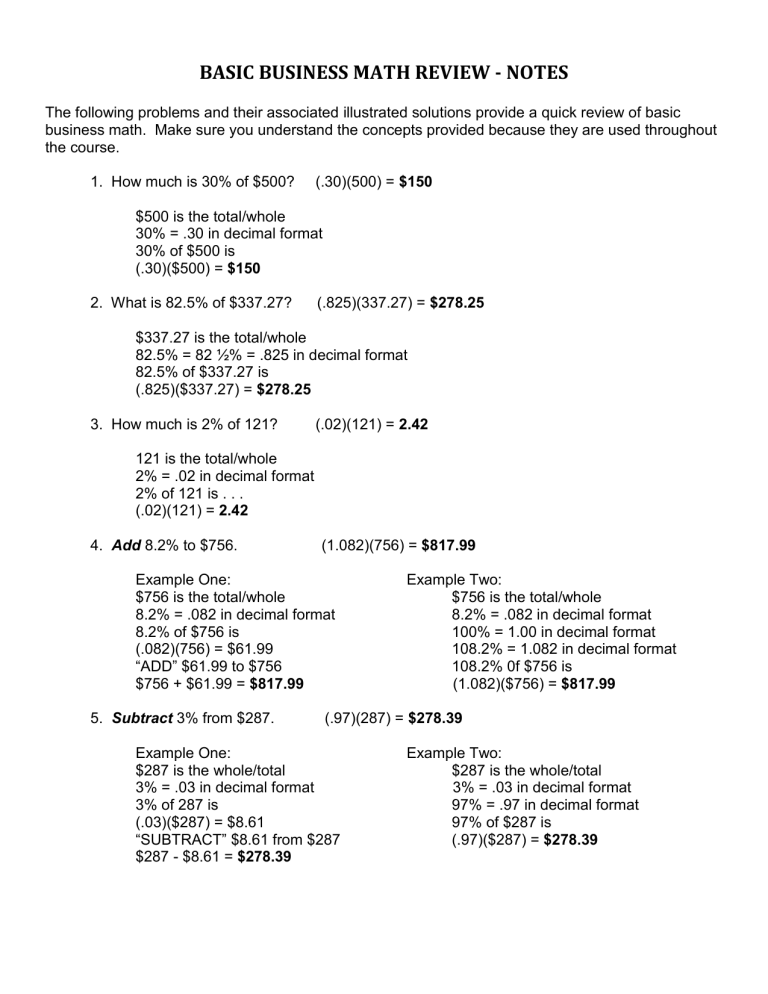
BASIC BUSINESS MATH REVIEW - NOTES The following problems and their associated illustrated solutions provide a quick review of basic business math. Make sure you understand the concepts provided because they are used throughout the course. 1. How much is 30% of $500? (.30)(500) = $150 $500 is the total/whole 30% = .30 in decimal format 30% of $500 is (.30)($500) = $150 2. What is 82.5% of $337.27? (.825)(337.27) = $278.25 $337.27 is the total/whole 82.5% = 82 ½% = .825 in decimal format 82.5% of $337.27 is (.825)($337.27) = $278.25 3. How much is 2% of 121? (.02)(121) = 2.42 121 is the total/whole 2% = .02 in decimal format 2% of 121 is . . . (.02)(121) = 2.42 4. Add 8.2% to $756. (1.082)(756) = $817.99 Example One: $756 is the total/whole 8.2% = .082 in decimal format 8.2% of $756 is (.082)(756) = $61.99 “ADD” $61.99 to $756 $756 + $61.99 = $817.99 5. Subtract 3% from $287. Example Two: $756 is the total/whole 8.2% = .082 in decimal format 100% = 1.00 in decimal format 108.2% = 1.082 in decimal format 108.2% 0f $756 is (1.082)($756) = $817.99 (.97)(287) = $278.39 Example One: $287 is the whole/total 3% = .03 in decimal format 3% of 287 is (.03)($287) = $8.61 “SUBTRACT” $8.61 from $287 $287 - $8.61 = $278.39 Example Two: $287 is the whole/total 3% = .03 in decimal format 97% = .97 in decimal format 97% of $287 is (.97)($287) = $278.39 6. What percent is 30 of 50? 30/50 = .60 = 60% 50 is the whole/total 30 is the amount of the whole/total 30 is what percent of the whole (50) 30/50 is 30/50 = .60 or 60% 7. What percent of $121.37 is $36.50? 36.5/121.37 = .3007 or 30.07% $121.37 is the whole/total $36.50 is the amount of the whole/total $36.50 is what percent of the whole ($121.37) $36.50/$121.37 is $36.50/$121.37 = .3007 or 30.07% 8. What percent is 60 of 40? 60/40 = 1.5 or 150% 40 is the whole/total 60 is the amount of the whole/total 60 is what percent of the whole (40) 60/40 is 60/40 = 1.5 or 150% 9. If you earn $10,000 in 2006 and $12,000 in 2007, what is the percent change? Use signed difference/original. +2,000/10,000 = +.20 or +20% Example One: $10,000 is what you started with (base) $12,000 is what you have a year later $2,000 positive quantitative difference (The difference between $10,000 and $12,000) $2,000 difference / what you started with base ($10,000) $2,000/$10,000 = .20 or 20% . . . . . +.20 or +20% (signs matter) Example Two: What you have ($12,000) / by what you started with base ($10,000) $12,000/$10,000 = 1.20 or 120% Meaning:$12,000 is 120% of the base or 120% of $10,000 $10,000 = 100% $12,000 = 120% of the base Therefore a 20% increase 10. If you earn $120,000 in 2007 and $115,000 in 2008, what is the percent change? -5,000/120,000 = -.0417 or -4.17% Example One: $120,000 is what you started with (base) $115,000 is what you have a year later $5,000 negative quantitative difference (The difference between $120,000 and $115,000) $5,000 difference / what you started with base ($120,000) $2,000/$10,000 = -.0417% or -4.17% (signs matter) Example Two: What you have ($115,000) / by what you started with base ($120,000) $115,000/$120,000 = .9583 or 95.83% Meaning:$115,000 is 95.83% of the base or 95.83% of $120,000 $120,000 = 100% $115,000 = 95.83% of the base Therefore a 4.17% decrease = -4.17% 11. If 14% of a number is 112, what is the number? .14X = 112, X = 800 14% = .14 in decimal format X = unknown number or amount 14% of X is 112 .14X = 112 .14X/.14 = 112/.14 X = 800 12. Your salary is $13,500 after receiving an 8% increase, what was your original salary? 1.08X = 13,500, X = $12,500 X is your original salary or the unknown $13,500 is what you have AFTER the increase or raise Therefore: the $13,500 is 108% of the base or the unknown 108% = 1.08 in decimal format 108% of X(the base) is $13,500 1.08X = $13,500 1.08X/1.08 = $13,500/1.08 X = $12,500 13. After a 24% reduction, the price was $250, what was the original price? .76X = 250, X = $328.95 X is your original price or the unknown $250 is the price AFTER the 24% discount Therefore: the $250 is 76% of the base or original unknown price 76% = .76 in decimal format 76% of X (the base or original price) is $250 .76X = $250 .76X/.76 = $250/.76 X = $328.96 14. A 20% discount amounts to $50 a. What was the original price? b. What is the new price? .2X = 50, X = $250 250 – 50 = $200 X = original price 20% of X is the discount in dollars ($50) Therefore: 20% of the original price = $50 .20X = $50 .20X/.20 = $50/.20 X = $250 . . . . . Original Price $250 original price minus $50 discount is new price $250 - $50 = $200 new price 15. You buy something for $60.00 and want a gross profit of 50% based on cost. What do you sell it for? 1.5($60) = $90.00 Cost = $60.00 50% of the cost is what you want gross profit to be 50% of $60 = $30, $60 + $30 = $90 Or Cost = $60.00 100% of cost is cost, 1.00 X $60.00 = $60.00 1.50 = 150% 1.50($60) = $90 Meaning: 100% plus another 50% of the cost was added in one calculation 16. You produce a product for $12.50 and need an 85% gross profit based on cost. What is the selling price? 1.85($12.50) = $23.13 Cost = $12.50 85% of the cost is what you want gross profit to be 85% of $12.50 = $10.63, $12.50 + $10.63 = $23.13 Or Cost = $12.50 100% of cost is cost, 1.00 X $12.50 = $12.50 1.85 = 185% 1.85($12.50) = $23.13 Meaning: 100% plus another 85% of the cost was added in one calculation 17. You want to sell a product for $27.99 and make a gross profit on cost of 33 1/3%. What do you pay for the product? 1.33333C = $27.99, C = $20.99 C = unknown cost $27.99 = Selling Price (SP) .33333 = Gross Profit (GP) Based on Cost, 33 1/3% gross profit based on cost SP will be 100% + 33 1/3% of Cost, 100% of cost = cost, 33 1/3% of cost = gross profit Therefore: 1.33333C = Selling Price 1.33333C = $27.99 C = $20.99 18. You want to sell a product for $100.00 and you require a 40% gross profit based on Selling Price. What should you pay for the product? .60($100.00) = $60.00 Selling Price = 100% = $100.00 Cost of product = 60% of Selling Price Gross Profit = 40% of Selling Price Therefore: C = .60($100.00) C = $60.00 Therefore: GP = .40($100.00) = $40.00 Therefore: C = $100 - $40 = $60.00 19. You want to sell a product for $18.75 and you want a gross profit 15% based on selling price. What do you pay for the product? .85($18.75) = $15.94 Selling Price = 100% = $18.75 Cost of product = 85 of Selling Price Gross Profit = 15% of Selling Price Therefore: C = .85($18.75) C = $15.94 Therefore: GP = .15($18.75) = $2.81 Therefore: C = $18.75 - $2.81 = $15.94 20. What is the cost of an item that sells for $49.50 and has a Gross Profit Rate of 45% based on cost? 1.45C = $49.50, C = $34.14 Selling Price = $49.50 Gross Profit = 45% of Cost Cost is Unknown = C Therefore: Cost + Gross Profit = Selling Price C + .45(C) = $49.50, 1.45C = $49.50, C = $34.14 21. A radio sells for $75.75 and its gross profit rate based on cost is 37%. What is the Cost? 1.37C = $75.75, C = $55.29 Selling Price = $75.75 Gross Profit = 37% of Cost Cost is Unknown = C Therefore: Cost + Gross Profit = Selling Price C + .37(C) = $75.75, 1.37C = $75.75, C = $55.29 22. A Calculator sells for $100.00 and its cost is $60.00, what is: The Gross Profit Rate Based on Selling Price? $40/$100 = .40 = 40% The Gross Profit Rate based on Cost? $40/$60 = .66667 = 66.67% SP – COST = GROSS MARGIN, $100 - $60 = $40 (needed to find the gross margin) Therefore: based on selling price, GM/SP = $40/$100 = .40 or 40% Therefore: based on cost, GM/COST = $40/$60 = .66667 = 66.67% 23. The Gross Profit Rate of a Product is 40% of the Selling Price and it amounts to $23.47. What is the Selling Price? .40SP = $23.47, SP = $58.67 What is the Cost? $58.67 - $23.47 = $35.21 Gross Profit Rate is 40% of Selling Price Gross Profit is $23.47 Therefore: 40% of Selling Price = $23.47, .40SP = $23.47, SP = $58.67 Therefore: Selling Price – Gross Profit = Cost, $58.67 - $23.47 = $35.21 24. The Gross Profit on a coat is $93.25 which is a gross profit rate of 30% based on cost. What is the Cost? .30C = $93.25, C = $310.83 What is the Selling Price? $310.83 + $93.25 = $404.08 Gross Profit Rate is based on Cost Gross Profit Rate = 30% Gross Profit is $93.25 Therefore: 30% of the Cost is $93.25, .30C = $93.25, C = $310.83 Therefore: Cost + Gross Margin = Selling Price, $310.83 + $93.25 = $404.08 25. You put $150 dollars in a saving account and at the end of the year you have $163.98. How much Interest was earned? $163.98 - $150.00 = $13.98 The beginning amount subtracted from the ending amount will give you interest Interest Earned when it is an investment (Savings) Interest Paid when it is a loan, obligation, debt 26. Using the provided information, compute costs. Variable Cost per Unit = $10X Fixed Costs in Total = $50,000 If the company makes 10,000 units Variable Cost is: If the company makes 10,000 units Fixed Cost is: If the company makes 10,000 units Total Cost is: $100,000 $ 50,000 $150,000 Y = mx + b, Y = $10(10,000) + $50,000, Y = $150,000.00
